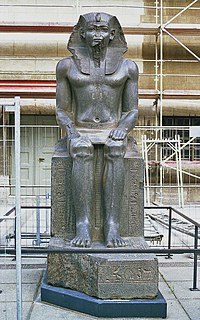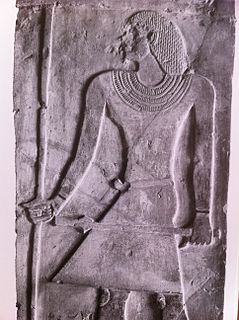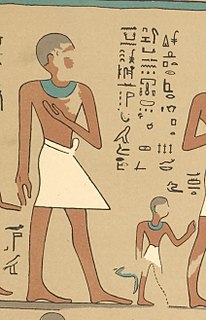Related Research Articles

The Middle Kingdom of Egypt is the period in the history of ancient Egypt following a period of political division known as the First Intermediate Period. The Middle Kingdom lasted from approximately 2040 to 1782 BC, stretching from the reunification of Egypt under the reign of Mentuhotep II in the Eleventh Dynasty to the end of the Twelfth Dynasty. The kings of the Eleventh Dynasty ruled from Thebes and the kings of the Twelfth Dynasty ruled from el-Lisht.

Pepi II Neferkare was a pharaoh of the Sixth Dynasty in Egypt's Old Kingdom who reigned from c. 2278 BC. His second name, Neferkare (Nefer-ka-Re), means "Beautiful is the Ka of Re". He succeeded to the throne at age six, after the death of Merenre I.

Nubkaure Amenemhat II was the third pharaoh of the 12th Dynasty of ancient Egypt. Although he ruled for at least 35 years, his reign is rather obscure, as well as his family relationships.

Senusret I also anglicized as Sesostris I and Senwosret I, was the second pharaoh of the Twelfth Dynasty of Egypt. He ruled from 1971 BC to 1926 BC, and was one of the most powerful kings of this Dynasty. He was the son of Amenemhat I. Senusret I was known by his prenomen, Kheperkare, which means "the Ka of Re is created."
Ptahhotep, sometimes known as Ptahhotep I or Ptahhotpe, was an ancient Egyptian vizier during the late 25th century BC and early 24th century BC Fifth Dynasty of Egypt.

Merhotepre Ini was the successor of Merneferre Ay, possibly his son, and the thirty-third king of the Thirteenth Dynasty of Egypt. He is assigned a brief reign of 2 Years, 3 or 4 Months and 9 days in the Turin Canon and lived during the early 17th century BC.

Neferkauhor Khuwihapi was an ancient Egyptian pharaoh of the Eighth Dynasty during the early First Intermediate Period, at a time when Egypt was possibly divided between several polities. Neferkauhor was the sixteenth and penultimate king of the Eighth Dynasty and as such would have ruled over the Memphite region. Neferkauhor reigned for little over 2 years and is one of the best attested kings of this period with eight of his decrees surviving in fragmentary condition to this day.

Ankhtifi was a nomarch of Hierakonpolis and a supporter of the pharaoh in Herakleopolis Magna, which was locked in a conflict with the Theban based 11th Dynasty kingdom for control of Egypt. Hence, Ankhtifi was possibly a rival to the Theban rulers Mentuhotep I and Intef I. He lived during the First Intermediate Period, after the Egyptian Old Kingdom state had collapsed, and at a time when economic hardship, political instability, and foreign invasion challenged the fabric of Egyptian society.

Ankhu was an Egyptian vizier of the early 13th Dynasty, who lived around 1750 BC.

Sobeknakht II was an ancient Egyptian local Governor at El-Kab and a supporter of the Theban 16th or 17th Dynasty during the Second Intermediate Period.

Aya was an ancient Egyptian king's wife of the early Thirteenth Dynasty.

Senedjemib Inti was a vizier from the Fifth Dynasty of Egypt during the reign of king Djedkare Isesi.
This page list topics related to ancient Egypt.

Djehutihotep was an ancient Egyptian nomarch of the fifteenth nomos of Upper Egypt during the twelfth dynasty, c. 1900 BC.

Shemay was an ancient Egyptian official and later vizier toward the end of the 8th Dynasty during the First Intermediate Period, mainly known for being the beneficiary of most of the Coptos Decrees. His career has been interpreted as a glaring sign of the extreme weakness of the central power, forced to bestow great privileges to maintain the loyalty of powerful local governors. Shemay is buried in a mudbrick mastaba just south of Coptos.
The Juridical Stela or Cairo Juridical Stela is an ancient Egyptian stele issued in c.1650 BCE. Kept at the Cairo Museum, its main purpose is to document the sale of a government office.

Kaikhenet was an ancient Egyptian local governor in the 10th Upper Egyptian province; the latter called Wadjet in Egyptian language. Kaikhenet lived at the beginning of the Fifth Dynasty and is known from his decorated rock cut tomb at Hemamieh. Decorated rock cut tombs are very rare in the Egyptian province before the end of the Fifth Dynasty. The tombs at Hemamieh are an exception. They belong to the earliest ones in the provinces.

Idy was an important Ancient Egyptian official in the Eighth Dynasty, at the beginning of the First Intermediate Period. He was the son of Shemay, who is also known from several monuments and decrees from Koptos. His mother was the king's daughter Nebet. Idy appears on many royal decrees found at Koptos. There he bears the important title of a vizier, but was also overseer of Upper Egypt and overseer of priest and count. The decrees are dated under king Neferkauhor and Neferirkare. One decree is addressed to Shemay and dates under Neferkauhor. It reports the appointment of Idy to the overseer of Upper Egypt. A second one mentions affairs in the temple of Min at Koptos. In a third decree Idy bears the titles of a vizier. In the decree, the king protects the statues and the funerary cult of Idy. The decree is dated under king Neferirkare, who was the successor of Neferkauhor. It seems that Idy took over many positions that his father hold before.
Tjetju was an ancient Egyptian official at the end of the Old Kingdom or in the First Intermediate Period. He held a series of high titles making him to one of the most influential people at the royal court. He most important title was that of the vizier. He was also overseer of the treasuries, overseer of the six big houses, overseer of the two granaries and overseer of all royal work of the king.

Sedjemnetjeru was an ancient Egyptian artist who worked and lived in the Second Intermediate Period in Elkab and Nekhen. He is one of the very few Ancient Egyptian artists who is known from several inscriptions and whose work is also known. Sedjemnetjeru is depicted in the tomb of Horemkhauef where he bears the titles draughtsman and great one of the tens of Upper Egypt. The first title shows that he was an artist and it seems most likely that he painted the decoration in the tomb of Horemkhauef. Sedjemnetjeru is also mentioned in the tomb of the local governor Sobeknakht II and it seems likely that he painted this tomb too. Here he is shown in the procession behind the tomb owner's catafalque. Here he bears again the titles great one of the tens of Upper Egypt and draughtsman. Finally, Sedjemnetjeru is also mentioned in the tomb of a certain Hormin, that he most likely decorated too.
References
- ↑ Juan Carlos Moreno García (2013) Ancient Egyptian Administration, p. 557
- ↑ Joseph John Tylor: Wall drawings and monuments of El Kab, The Tomb of Sebeknekht, London 1896, pl. XI
- ↑ Vivian Davies: The tomb of a Governor of Elkab of the Second Intermediate Period, in: Gianluca Miniaci, Wolfram Grajetzki (editors): The World of Middle Kingdom Egypt (2000-1550 BC), London 2016, ISBN 9781906137489, pp. 71-84